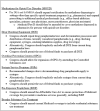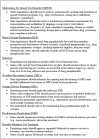U.S. substance use harm reduction efforts: a review of the current state of policy, policy barriers, and recommendations
- PMID: 40484964
- PMCID: PMC12147315
- DOI: 10.1186/s12954-025-01238-4
U.S. substance use harm reduction efforts: a review of the current state of policy, policy barriers, and recommendations
Abstract
A wealth of research demonstrates that harm reduction interventions for substance use (SU) save lives and reduce risk for serious infectious diseases such as HIV, hepatitis C, and other SU-related health conditions. The U.S. has adopted several harm reduction interventions at federal and state levels to combat SU-related harm. While several policy changes on the federal and state levels decriminalized interventions and further support their use, other policies limit the reach of these interventions by delaying or restricting care, leaving access to life-saving interventions inconsistent across the U.S. Federal and state policies in the U.S. that restrict access to medications for opioid use disorder (MOUD), criminalize possession of drug paraphernalia, prevent syringe service programs and overdose prevention centers from operating, and limit prescribing of pre-exposure prophylaxis (PrEP) pose significant barriers to harm reduction access and implementation. This paper aims to bridge publications and reports on current state and federal harm reduction intervention policies and discuss policy recommendations. Federally, the DEA and SAMHSA should expand certification for methadone dispensing to settings beyond dedicated opioid treatment programs and non-OTP prescribers. Congress can decriminalize items currently categorized as paraphernalia, permit purchasing of syringes and all drug checking equipment using federal funds, amend the Controlled Substances Act to allow for expansion of overdose prevention centers, protect Medicaid coverage of PrEP, and expand Medicaid to cover residential SU treatment. At the state level, states can reduce regulations for prescribing MOUD and PrEP, decriminalize drug paraphernalia, codify Good Samaritan laws, and remove restrictions for syringe service program and overdose prevention center implementation. Lastly, states should expand Medicaid to allow broader access to treatment for SU and oppose Medicaid lock-outs based on current SU. These changes are needed as overdose deaths and serious infectious disease rates from SU continue to climb and impact American lives.
Keywords: Drug checking equipment; Medications for opioid use disorder; Naloxone; Overdose prevention centers; Pre-exposure prophylaxis; Syringe service programs.
© 2025. The Author(s).
Conflict of interest statement
Declarations. Competing interests: The authors declare no competing interests.
Figures






Similar articles
-
Systematic Evaluation of State Policy Interventions Targeting the US Opioid Epidemic, 2007-2018.JAMA Netw Open. 2021 Feb 1;4(2):e2036687. doi: 10.1001/jamanetworkopen.2020.36687. JAMA Netw Open. 2021. PMID: 33576816 Free PMC article.
-
Responsible Controlled Substance and Opioid Prescribing.2025 Mar 28. In: StatPearls [Internet]. Treasure Island (FL): StatPearls Publishing; 2025 Jan–. 2025 Mar 28. In: StatPearls [Internet]. Treasure Island (FL): StatPearls Publishing; 2025 Jan–. PMID: 34283451 Free Books & Documents.
-
Harm Reduction: The Neglected Pillar of US Drug Policy.Annu Rev Public Health. 2025 Apr;46(1):369-387. doi: 10.1146/annurev-publhealth-071723-112620. Epub 2024 Dec 17. Annu Rev Public Health. 2025. PMID: 39689280 Review.
-
"Yeah, this is not going to work for me"-The impact of federal policy restrictions on methadone continuation upon release from jail or prison.J Subst Use Addict Treat. 2025 Jan;168:209538. doi: 10.1016/j.josat.2024.209538. Epub 2024 Oct 10. J Subst Use Addict Treat. 2025. PMID: 39393533
-
Harm reduction in the USA: the research perspective and an archive to David Purchase.Harm Reduct J. 2017 Jul 26;14(1):51. doi: 10.1186/s12954-017-0178-6. Harm Reduct J. 2017. PMID: 28747189 Free PMC article. Review.
References
-
- Substance Abuse and Mental Health Services Administration. Key substance use and mental health indicators in the United States: Results from the 2023 National Survey on Drug Use and Health [Internet]. Rockville, MD: Center for Behavioral Health Statistics and Quality, Substance Abuse and Mental Health Services Administration; 2024 July. Available from: https://www.samhsa.gov/data/sites/default/files/reports/rpt47095/Nationa.... Accessed 1 Oct 2024.
-
- Centers for Disease Control and Prevention. Understanding drug overdoses and deaths[Internet]. Atlanta, GA: Centers for Disease Control and Prevention;2023 May 8. Available from: https://www.cdc.gov/drugoverdose/epidemic/index.html. Accessed 22 May 2023.
-
- Ahmad FB, Cisewski JA, Rossen L. M., Sutton P. Provisional drug overdose death counts [Internet]. Hyattsville, MD: National Center for Health Statistics; 2024. Available from: 10.15620/cdc/20250305008. Accessed 16 April 2024.
-
- State Unintentional Drug Overdose Reporting System (SUDORS) Final Data. [Internet]. Atlanta, GA: USDepartment of Health and Human Services, CDC; 2024 December 12[cited]. Available from: https://www.cdc.gov/overdose-prevention/data-research/facts-stats/sudors.... Accessed 24 March 2025.
-
- Valasek C, Bazzi AR. Intersectionality and structural drivers of fatal overdose disparities in the United States: a narrative review. Curr Addict Rep. 2023;10(3):432–40.
Publication types
MeSH terms
LinkOut - more resources
Full Text Sources
Medical
Miscellaneous

